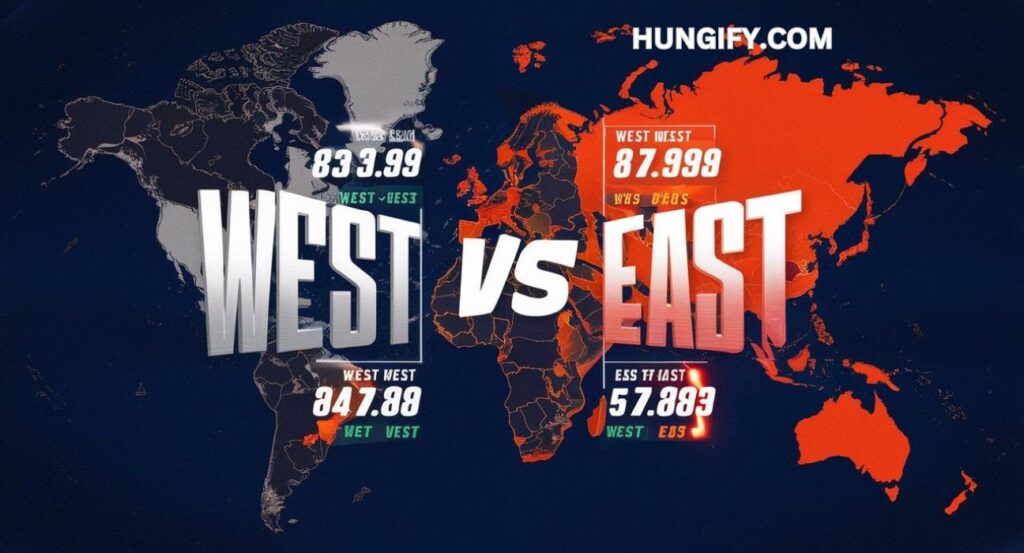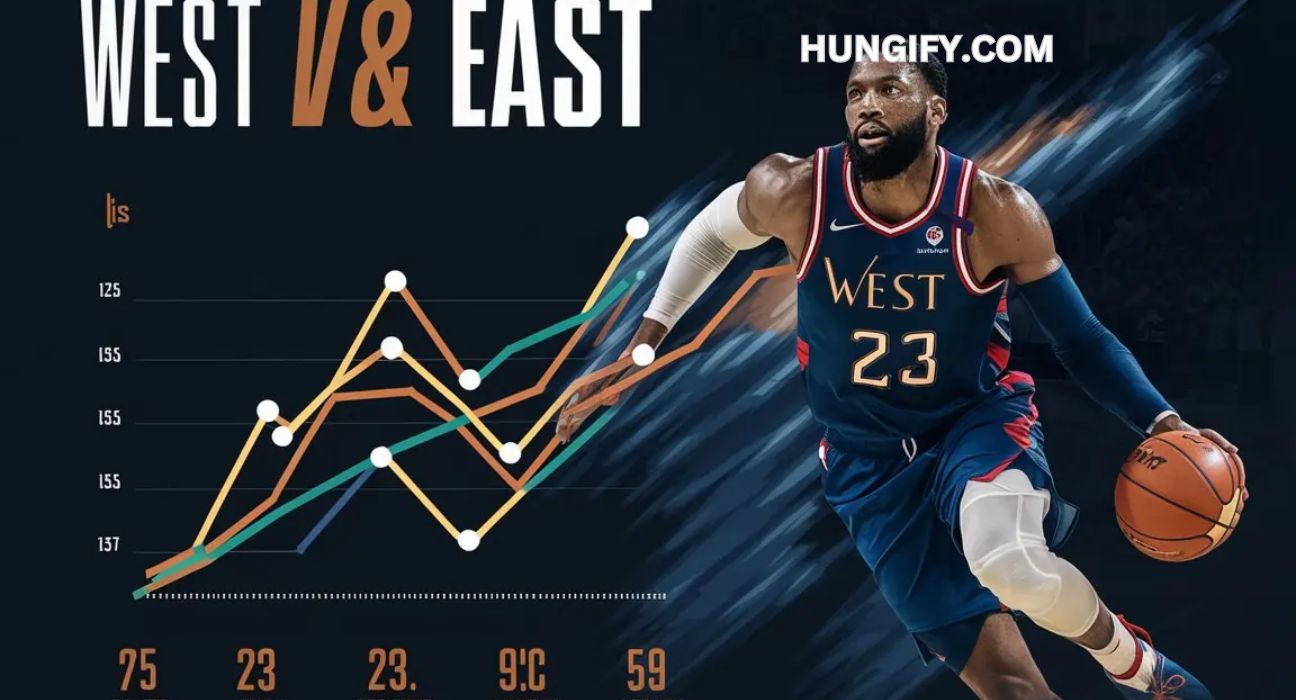Introduction
The ongoing rivalry between the Western and Eastern Conferences has always been a highlight of the sports world, with the player stats from these matchups being a significant focus. Whether it’s basketball or another sport, comparing stats between players from these two conferences provides insights into the unique playing styles, offensive tactics, and defensive strategies that define each side. In this article, we’ll dive deep into West vs East match player stats, examining key metrics, historical trends, and standout performances that shape the narrative.
Read More: TabletWritings.com Blog: Your Ultimate Resource for Tablet-Based Writing
Key Offensive Stats Comparison
Points Per Game (PPG): Who Leads in Scoring?
When comparing West vs East match player stats, one of the most crucial metrics is points per game (PPG). Historically, the Western Conference has often been seen as more offensively focused, with many high-scoring games due to faster-paced play. In contrast, Eastern Conference teams often rely on structured, half-court sets, which can result in fewer possessions but more efficient shot selection.
Three-Point Shooting: Efficiency and Range
A key stat in West vs East matchups is three-point shooting efficiency. Western teams, known for their fast-paced, high-scoring offense, typically excel in three-point shooting, with players like Stephen Curry setting the standard. Eastern teams, on the other hand, may focus more on inside scoring but have improved their long-range shooting over time, bringing balance to their offensive attack.
Field Goal and Free Throw Percentages
Field goal percentage (FG%) often favors Western players, due to their ability to create open shots during transition plays. However, Eastern teams tend to be more consistent at drawing fouls and converting free throws, with some of the best free-throw shooters in the league coming from the East. These shooting percentages reflect the contrasting offensive strategies of both conferences.
Defensive Stats Breakdown
Blocks and Steals: Who Dominates Defense?
When evaluating West vs East match player stats, defensive stats such as blocks and steals are crucial. Western Conference teams often rely on quick, aggressive defense, resulting in more steals and fast-break opportunities. Meanwhile, Eastern Conference players are often known for their interior defense, excelling in shot-blocking and altering shots around the rim.
Rebounds: Controlling the Boards
Rebounding is another key stat that highlights the differences between the West and East. Eastern teams tend to prioritize size and interior presence, leading to higher rebounding numbers, especially in defensive rebounds. Western teams, while still strong on the boards, often rely on quick transitions rather than crashing the glass on every possession.
Defensive Efficiency: A Key Metric
Defensive efficiency measures how well a team prevents opponents from scoring per possession. Eastern teams often display a more disciplined, structured defense, leading to higher defensive efficiency ratings. Western teams, with their focus on speed, may allow more points but can compensate with their high offensive output.

Player Efficiency Metrics
Player Efficiency Rating (PER)
The Player Efficiency Rating (PER) is a metric that provides insight into a player’s overall performance. Western stars typically boast higher PERs due to their involvement in fast-paced, high-scoring games. However, Eastern Conference players often have equally impressive PERs, particularly those who excel in both offense and defense.
Plus/Minus (+/-): Measuring Player Impact
The plus/minus (+/-) statistic measures the point differential while a player is on the court. In West vs East matches, this stat is essential for identifying players who impact the game beyond traditional box score numbers. For example, a player may not score a lot but could have a significant positive impact on the game’s outcome through defensive stops or facilitating the offense.
Usage Rate (USG%)
Usage rate measures how often a player is involved in offensive plays. In Western teams, usage rates are often higher for star players due to the offensive-heavy approach. Eastern teams might spread the ball more evenly, focusing on a balanced attack with lower individual usage rates.
Historical Trends and Statistical Insights
How Have West vs East Matchups Evolved?
The West vs East match player stats have shifted over the years, reflecting broader changes in play styles. Historically, Western Conference teams have favored a fast-paced, offense-first approach, while the East has been known for slower, more physical play. However, modern analytics and improved player development have seen these distinctions blur, with both conferences adopting elements of each other’s play styles.
Key Stats Defining Past and Present Games
Past matchups between the Western and Eastern Conferences often show distinct patterns. For instance, high-scoring Western teams would typically have higher assists and three-point attempts, while Eastern teams would dominate in rebounding and defense. Analyzing these key stats provides a comprehensive understanding of how matchups have evolved.
Read More: eworldexternal .com: Your Comprehensive Guide to the Digital Platform
Notable Performances in West vs East Games
Highlighting Standout Players
In West vs East matchups, several players have delivered game-changing performances. Players like LeBron James from the Eastern Conference have consistently put up dominant numbers in terms of scoring, rebounding, and assists. On the Western side, players like Kevin Durant have showcased elite offensive skill, making these matchups highly competitive.
Game-Changing Plays
Specific moments in West vs East games have been defined by individual brilliance, with players stepping up in critical moments. Whether it’s a buzzer-beater three-pointer or a game-saving block, these performances often become iconic in the ongoing rivalry between the two conferences.
Impact of Playing Styles on Stats
Fast-Paced West vs Structured East
The fast-paced play of the Western Conference often leads to higher scoring games, with a focus on quick transitions and fast-break points. In contrast, Eastern Conference teams generally emphasize half-court offense, creating fewer possessions but higher-quality shots. These contrasting styles significantly impact player stats in these matchups.
Tempo and Ball Movement
Western teams tend to rely on rapid ball movement and shooting, leading to higher assist numbers. Eastern teams, by contrast, might focus more on post-play and setting up scoring opportunities through physical, methodical ball movement.
Advanced Analytics in West vs East Matchups
Metrics like Win Shares and PER
Advanced metrics such as Win Shares and PER provide deeper insights into how individual players contribute to their team’s success in West vs East matchups. These analytics offer a clearer picture of a player’s value beyond traditional stats like points and assists.
Role of Big Data in Player Stats
In modern matchups, big data and analytics play a crucial role in assessing performance. Coaches and analysts use metrics such as true shooting percentage (TS%) and defensive rating to make strategic decisions, making advanced analytics essential in understanding player contributions.
West vs East Match Player Stats Predictions
When looking at West vs East match player stats predictions, analysts typically focus on previous performances, current form, and key player matchups to forecast potential outcomes. For example, based on historical data, Western Conference teams might be predicted to lead in three-point shooting, while Eastern Conference players may dominate defensively. These predictions help fans and analysts anticipate game trends and standout players before each matchup.
West vs East Match Player Stats MVP
In West vs East match player stats MVP discussions, the focus is often on players who significantly impact the game with their scoring, defense, or leadership. Players with high PER (Player Efficiency Rating) and consistent all-around contributions often rise as MVP candidates. Recent MVPs in such matchups are typically star players from both conferences who shine in crucial moments, whether it’s by delivering key assists, scoring in crunch time, or playing lockdown defense.
West vs East Match Player Stats 2023
In West vs East match player stats 2023, the trends showed a more balanced competition between the conferences, with the Western Conference maintaining its reputation for high-paced offense, while Eastern Conference players displayed improved efficiency in both offense and defense. Player stats from 2023 revealed standout performances in areas like rebounding and playmaking, contributing to the ongoing excitement surrounding this rivalry.

Conclusion: Which Conference Holds the Edge?
When comparing West vs East match player stats, it’s clear that both conferences bring unique strengths. The Western Conference tends to dominate in offensive categories like three-point shooting and fast-break points, while the Eastern Conference excels in defense and rebounding. Ultimately, these matchups are highly competitive, and each game offers new insights into the strengths of both sides. As the rivalry continues, player stats will remain a key factor in determining which conference holds the advantage.
Read More: Make1m .com: Your Gateway to Financial Freedom
Frequently Asked Questions
1. Which conference scores more points in West vs East matchups?
The Western Conference typically scores more points due to their fast-paced, offense-driven style. They often excel in three-point shooting and fast-break opportunities.
2. How do defensive stats compare between the West and East?
Eastern Conference teams generally have stronger defensive stats, with a focus on rebounding and shot-blocking, while the West often generates more steals and fast-break points from turnovers.
3. Who are the top scorers in recent West vs East matchups?
Top scorers in these matchups include Western stars like LeBron James and Stephen Curry, and Eastern Conference players like Giannis Antetokounmpo, who consistently lead in points per game.
4. How does the Player Efficiency Rating (PER) differ between conferences?
Western Conference players often have higher PER due to their offensive contributions, while Eastern Conference players balance their PER with strong defensive stats.
5. What is the role of assists in West vs East match player stats?
Western teams tend to lead in assists, relying on ball movement and fast-paced plays. Eastern teams often focus on structured play, leading to fewer but more efficient assists.
6. Which conference dominates in rebounding stats?
Eastern teams typically dominate rebounding stats, especially defensive rebounds, due to their physical, structured play and focus on interior defense.
7. How do three-point shooting stats compare between West and East?
The Western Conference leads in three-point shooting percentage, with players like Stephen Curry and Klay Thompson setting records in long-range accuracy.
8. Who leads in MVP stats during West vs East matches?
MVP honors often go to players who excel in all-around stats like points, rebounds, and assists. Recent MVPs include players from both conferences who deliver in clutch moments.
9. How do team defensive efficiencies compare in West vs East games?
Eastern Conference teams tend to have higher defensive efficiency, focusing on half-court defense, while the Western Conference may allow more points due to their faster pace of play.
10. What advanced metrics are used in West vs East match player stats?
Advanced metrics like Win Shares and Plus/Minus are commonly used to analyze player impact. The West typically excels in offensive Win Shares, while the East often leads in defensive metrics.
